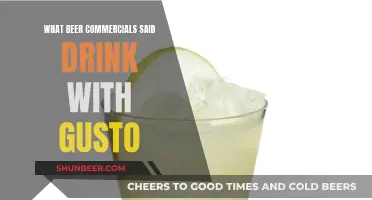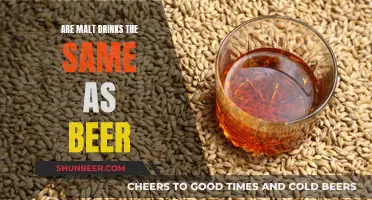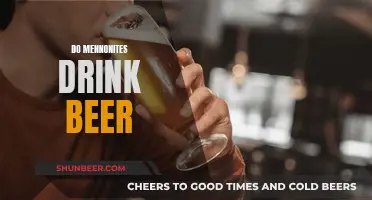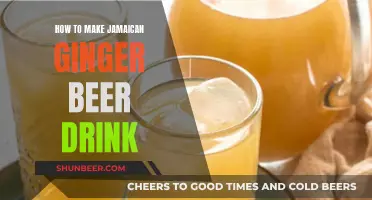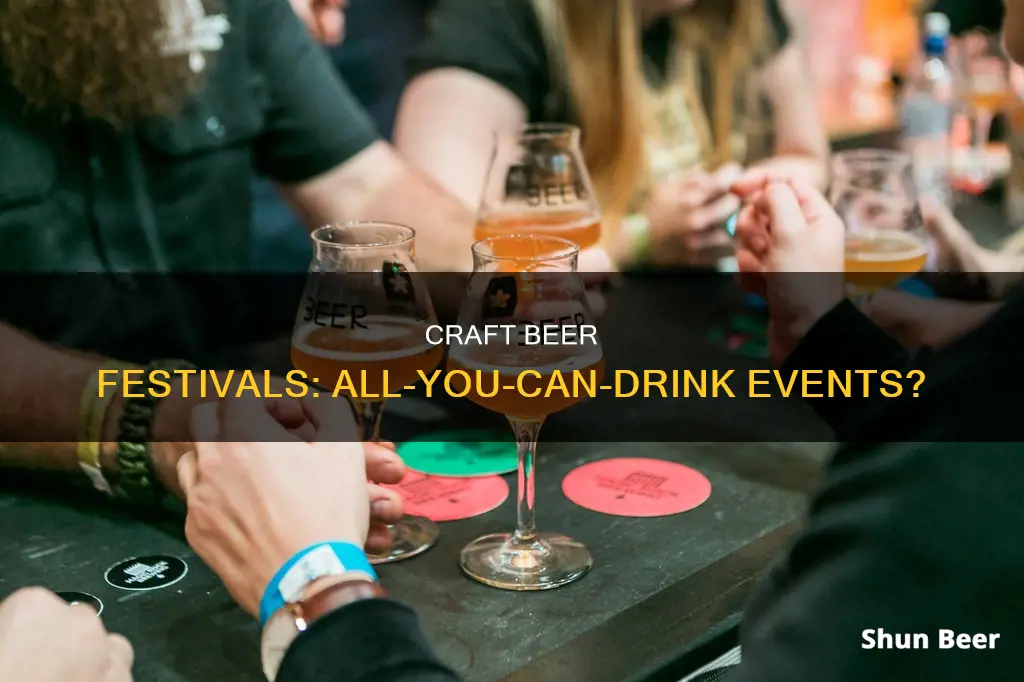
Beer festivals have become vibrant celebrations of craft brewing, attracting beer enthusiasts from all walks of life. These festivals typically showcase a diverse range of local and regional breweries, offering attendees the opportunity to sample a wide variety of unique and innovative beer styles. While the specific format of these festivals may vary, one common question that often arises is whether craft beer festivals are all-you-can-drink events. This query stems from the desire to make the most of the festival experience and get the best value for money. In the past, the stereotypical beer festival involved paying a fixed price for a limited time slot, during which attendees could sample numerous breweries' offerings in small quantities. However, the landscape of craft beer festivals is evolving, with a shift towards more niche and specialized events.
| Characteristics | Values |
|---|---|
| Attendance Cost | $75 for a three-hour time slot |
| Beer Volume | Two-ounce pours |
| Time Limit | Three hours |
| Number of Breweries | Dozens |
| Beer Volume | 8-12 beers in Texas |
| Additional Cards/Tickets | Available for purchase in Texas |
| Beer Styles | Hop-forward IPAs, rich stouts, sour ales |
| Festival Features | Live music, food trucks, educational sessions |
| Festival Setting | Sprawling urban parks, small-town settings |
| Festival Duration | One day, three days |
What You'll Learn

Craft beer festivals are becoming more niche and specialised
Craft beer festivals are evolving to meet the changing needs and preferences of consumers. As the craft beer industry has matured, so too have the tastes and knowledge of its consumers. As a result, craft beer festivals are becoming more niche and specialised.
The traditional model of a craft beer festival involved paying a set fee for a limited time slot, during which attendees could sample a variety of beers from numerous breweries. These festivals often took place in convention centres and were organised by event production companies. However, this model has become less appealing to consumers, who no longer see the novelty in paying a premium to wait in long lines for small samples of beer.
The decline of these generic, one-size-fits-all festivals has given way to the rise of more niche and specialised events. These new festivals are often smaller in scale and focus on specific styles or categories of beer, such as low-ABV lagers, barrel-aged beers, or cask beers. For example, festivals like Little Beer, Pils & Love, and FoBAB cater to enthusiasts of particular types of beer, rather than trying to appeal to a broad audience.
These niche festivals are typically organised by breweries or local guilds, allowing them to leverage their strengths, tap into their networks, and cater directly to their target communities. By specialising, these festivals can offer a more intimate and tailored experience to attendees, who often already know their preferences and are looking for something specific.
The shift towards niche and specialised craft beer festivals reflects the maturation of the industry and its consumers. With the proliferation of breweries and taprooms, consumers now have easier access to a diverse range of craft beers without having to attend a festival. As a result, festivals must adapt to remain relevant and engaging, providing unique experiences, specialised offerings, and added value to attract consumers.
Drinking Beer at Solomon's Island Boat Ramp: Is it Allowed?
You may want to see also

The novelty of trying many different beers has worn off for some
The stereotypical beer festival, with its three-hour time slot, dozens of breweries, and two-ounce pours, is becoming less appealing to some craft beer drinkers. The "try as many beers as you can" model is losing its lustre, as attendees tire of the challenge of sampling numerous beers in a limited time, often thwarted by long lines. This format, which was once ubiquitous, may be on its way out.
Indeed, the decline in attendance at large, one-size-fits-all festivals suggests that the novelty of trying countless different beers has worn off for many craft beer enthusiasts. This is particularly true for older drinkers, who are no longer the most eager demographic for an all-you-can-drink frenzy. As Chris McClellan, Pubinno "chief beer officer" and Resin cofounder, observes, "I think the novelty of going and trying 8 million different two-ounce samples has gone off for a lot of people...It’s fun once or twice or 10 times, but now the industry has matured and sits in a different place in the consumer mindset than it used to."
The proliferation of breweries and taprooms means that beer lovers can easily try new beers without attending a festival. As a result, many are opting to skip the long lines and high ticket prices of festivals in favour of more intimate, local experiences. This shift in consumer preferences has led to the rise of smaller, more specialised festivals that cater to specific tastes and offer a more curated selection of beers.
Breweries are responding to this trend by hosting their own events or collaborating with local guilds to create focused festivals that showcase particular styles or categories of beer. These niche festivals provide a more intimate and tailored experience for attendees, allowing them to connect with fellow enthusiasts who share their specific interests within the diverse world of craft beer.
While the traditional beer festival model may be losing its appeal, the craft beer festival is certainly not going away. Instead, it is evolving to meet the changing needs and preferences of a more mature and discerning audience.
Beer and Pepto-Bismol: A Safe Mix?
You may want to see also

Festivals are becoming smaller and hyper-niche
The craft beer festival scene is evolving. While the stereotypical beer festival involves paying a fee for a limited time slot to sample as many beers as possible, COVID-19 put a stop to these large-scale events, and they haven't made a triumphant return. Instead, a growing roster of more niche events has sprung up.
These smaller, hyper-niche festivals are message-driven, reflecting a more mature audience with a more discerning palate. They are often organised by breweries or local guilds, rather than event production companies, allowing them to be more specialised. For example, Barrel & Flow is a festival aimed at increasing representation and removing barriers for BIPOC in the beer industry. Other festivals are style- or category-themed, such as Chicago's FoBAB, a festival of barrel-aged beer, or Thank You for Smoking, a smoked beer party thrown by Dovetail Brewery, also in Chicago.
The shift towards smaller, hyper-niche festivals is also seen in the music festival scene. In recent years, a wave of smaller, more niche music festivals has started to fill in the gaps between massive, multi-genre events. These niche festivals are often genre-specific, like Cruel World Festival, which is dedicated to '80s new wave, or the pop-punk nostalgia festival, Adjacent Festival. Niche festivals can also be themed around a specific era of music, like Cruel World, which is also '80s-themed, or a specific subculture, like the goth and new wave-focused Cruel World Festival.
Niche festivals offer a more intimate and low-key experience, and they often attract a different crowd. They are also more affordable, with tickets typically costing less than those for larger festivals. Niche festivals are usually located close to a major market, so attendees can enjoy a day of music and then go home to their own beds. This is especially appealing to those who are no longer eager to attend large-scale events that require camping or expensive accommodation.
The rise of niche festivals is a response to changing consumer tastes and the increasing expense of the main festival circuit. Niche festivals also offer a sense of community and a more discerning experience, which can be appealing in the streaming era when listeners are inundated with multiple styles of music. They provide a reunion-like experience, where fans know each other from the scene, and artists run into friends and former collaborators backstage.
The success of niche festivals lies in the network effect, where each additional participant increases the value of the network. This has been leveraged by startups like Charge, which has found a way to engage with a captive, vibrant community by targeting these niche festivals. The growth of niche festivals has been exponential, with an approximately 30% increase in ticket sales over the past five years, according to Music Festival Wizard.
So, whether it's craft beer or music, the future of festivals is small and hyper-niche.
Exploring Beer Consumption on Mounjaro: What You Need to Know
You may want to see also

They are also becoming more message-driven
Craft beer festivals are becoming more message-driven, reflecting an audience that has matured in age and beer knowledge. As consumers have become more discerning, with a better understanding of their preferences, the festivals are evolving to cater to specific interests and communities. This shift is also a response to the decline in attendance at large, one-size-fits-all festivals, which have struggled to return to their pre-COVID popularity.
The new wave of message-driven festivals is characterised by their focus on certain themes or categories, such as beer styles, social causes, or specific target audiences. By catering to niche interests, these festivals create a more intimate and specialised experience for attendees. For example, there are festivals dedicated to low-ABV lagers and English styles, barrel-aged beers, and smoked beers. This shift towards specialisation allows breweries to leverage their strengths, collaborate with their networks, and speak directly to their target communities.
In addition to being more niche-focused, craft beer festivals are also becoming more inclusive. Some festivals, like Queer Beer Fest, Drink Like a Girl Fest, and Fresh Fest, are specifically designed to increase representation and remove barriers for underrepresented groups in the beer industry, such as BIPOC and LGBTQIA+ individuals. These festivals often feature breweries owned by or employing people from these communities, as well as collaboration beers created with them. Organisers of major festivals like the Great American Beer Festival and the Great British Beer Festival have also implemented measures to create more inclusive environments, such as publishing diversity best practices and instituting visible codes of conduct.
The move towards message-driven festivals is a response to changing consumer preferences and a more mature craft beer industry. As Chris McClellan, Pubinno "chief beer officer" and Resin cofounder, observes, consumers are no longer content with the "try as many beers as you can" model that characterised early craft beer festivals. Instead, they seek out festivals that align with their specific interests, whether it's a particular beer style or a social cause they care about. This evolution in craft beer festivals demonstrates the industry's maturation and its efforts to create more tailored and inclusive experiences for a diverse range of beer enthusiasts.
Root Canal Recovery: Beer, Yes or No?
You may want to see also

Some festivals are all-you-can-drink
Some craft beer festivals are all-you-can-drink events. The Milwaukee Brew Fest, for example, offers unlimited tastings of beers, ciders, and meads from over 100 breweries. Similarly, the Minnesota Craft Beer Festival features over 400 unique beers from more than 100 local breweries.
In Texas, however, beer festivals tend to give attendees a set amount of drinks, usually between 8 and 12, with the option to purchase additional cards or tickets. This is a departure from the stereotypical beer festival, where attendees pay a flat fee for a set time slot to sample as many beers as possible within that time frame.
The COVID-19 pandemic significantly impacted the beer festival landscape, with many popular festivals either ending or being put on indefinite hold. As a result, the industry has seen a shift towards more niche and specialized events, reflecting the maturing tastes and preferences of craft beer consumers. These focused festivals are often organized by breweries or local guilds and cater to specific styles or categories of beer, such as low-ABV lagers, English styles, or barrel-aged beers.
Despite the changes in the festival landscape, the sense of community fostered by these events remains a defining feature, with attendees gathering to share their love of craft beer, connect with fellow enthusiasts, and engage with brewers.
Beer Drinking: A Deadly Risk for Puppies
You may want to see also
Frequently asked questions
Craft beer festivals are vibrant celebrations of brewing that attract enthusiasts from all walks of life. They showcase a diverse range of local and regional breweries, offering attendees the chance to sample a wide array of unique beer styles. Beyond the beer tastings, many festivals also feature live music, food trucks, and educational sessions.
It depends on the festival. Some festivals offer unlimited tastings, while others provide a set amount of samples, with additional samples available for purchase. The Milwaukee Brew Fest, for example, offers unlimited tastings of beers, ciders, and meads from over 100 breweries.
The cost of craft beer festivals can vary. Some festivals charge around $75 for a three-hour time slot, while others may offer different pricing tiers or discounts for designated drivers.
Some popular craft beer festivals in the US include the Great American Beer Festival in Denver, the Big Texas Beer Fest in Dallas, the Oregon Brewers Festival in Portland, and the Minnesota Craft Beer Festival in Minneapolis.


